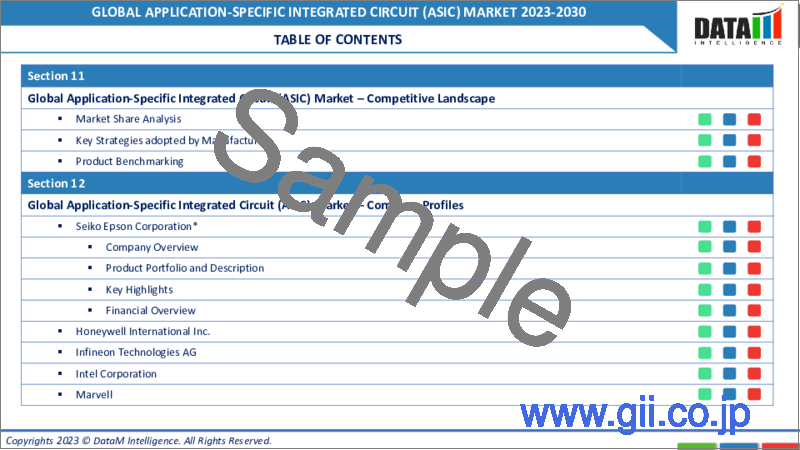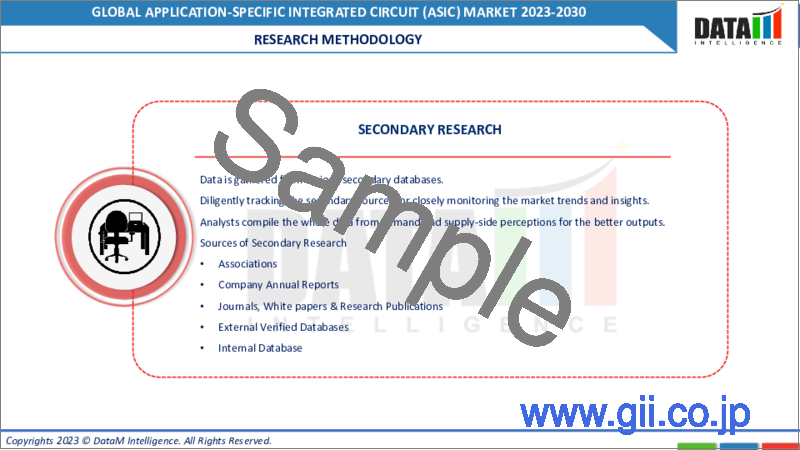|
|
市場調査レポート
商品コード
1316220
ASIC(特定用途向け集積回路)の世界市場-2023年~2030年Global Application-Specific Integrated Circuit (ASIC) Market - 2023-2030 |
||||||
カスタマイズ可能
適宜更新あり
|
|||||||
| ASIC(特定用途向け集積回路)の世界市場-2023年~2030年 |
|
出版日: 2023年07月27日
発行: DataM Intelligence
ページ情報: 英文 205 Pages
納期: 即日から翌営業日
|
- 全表示
- 概要
- 目次
市場概要
ASIC(特定用途向け集積回路)の世界市場は、2022年に157億米ドルに達し、2023~2030年の予測期間中にCAGR 8.3%で成長し、2030年には345億米ドルに達すると予測されています。ASIC(特定用途向け集積回路)分野の発展には、メーカーの大量生産能力が不可欠です。潜在的な用途があるにもかかわらず、エンドユーザー部門が大量生産を求め続けているため、コストは引き続き中小企業の成長にとって重要な障壁となっています。市場参入企業はこのような新興国市場の開発に対応するため、特殊性を減らした製品開発サイクルを短縮しています。
アジア太平洋地域の成長と人気は著しく、2022年には世界のASIC(特定用途向け集積回路)市場の1/3以上を占めています。自動車産業の成長は集積回路の必要性に寄与し、ICメーカーに生産設備の拡大を促しています。例えば、2022年8月、アナログICファウンドリーのGTA Semiconductorは、上海パイロット自由貿易区の臨港特別区で生産能力拡大プロジェクトを開始しました。
市場力学
5Gの普及拡大
5G技術の採用拡大が5G対応スマートフォンの需要を牽引し、世界のASIC(特定用途向け集積回路)市場の成長を支えています。5Gが可能にする高速データ通信は、産業オートメーションやAI、IoTなどの新技術の採用を促進すると期待されています。このようなインフラ構築に使用される電子機器が増えるにつれ、アナログ回路の需要は増加するとみられます。
中国はまた、コンシューマーエレクトロニクスの最大の生産国およびユーザーのひとつでもあります。中国税関によると、同国の2021年の輸出額は約3兆3,600億米ドルで、前年比30%増となっています。コンシューマーエレクトロニクスやその他の電気製品が輸出額の大部分を占めるため、世界のASIC市場は持続的な成長を示すと予想されます。
通信機器の需要増加
通信機器へのニーズの高まりがASIC(特定用途向け集積回路)市場の拡大を後押ししています。近年のスマートフォンやスマートホームガジェットの急速な普及が、インドや韓国の集積回路需要を押し上げています。デジタル機器への第5世代(5G)無線技術の急速な採用も、連携機器やスマート製品の需要拡大に不可欠な要素であり、ASICの需要を押し上げています。
韓国情報社会振興院(KISDI)によると、韓国のスマートフォン所有率は2020年の91.2%、2019年の89.6%から2021年には92.7%に飛躍的に伸びた。同地域におけるスマートフォンの普及率のこうした上昇は、同市場における特定用途向けICの需要を増加させる可能性が高いです。
長い製造サイクルと限られた再利用性
ASICの開発は、設計、検証、製造、テストなど多くの工程から構成されることが多く、開発サイクルが長くなります。FPGAや汎用ICのような他の半導体デバイスと比較すると、ASICを市場に投入するまでに要する期間は長くなる傾向にあります。開発期間の長期化により、市場のニーズや技術改良に迅速に対応する能力が妨げられ、競争力が低下する可能性があります。
ASICは特殊な目的のために開発される傾向があり、製品や業界を超えた再利用が容易でない可能性があります。ASICは、汎用ICとは異なり、ある特定の機能のために設計されているため、多目的に再利用することが難しいです。異なる製品やバリエーションのために多くのASICを製造する必要がある企業にとって、この再利用性の欠如は、コスト削減や設計効率を制限する可能性があります。
COVID-19の影響分析
COVID-19パンデミックは集積回路業界に深刻な影響を与え、サプライチェーンの混乱と世界の製造停止を引き起こしました。しかし、ヘルスケア、遠隔地での雇用、オンライン通信など、いくつかの業界では流行中に需要が増加しました。医療機器、通信インフラ、データセンター、その他の主要技術で利用されるASICの重要性が増しました。その結果、他産業での需要が減少する一方で、これらの分野では需要増に見合うASIC製造の必要性が高まっています。
パンデミックは、さまざまな企業でデジタル変革を加速させました。組織や個人のデジタルサービスやテクノロジーへの依存度が高まるにつれ、高度なコンピューティングや人工知能(AI)、その他の発展途上のアプリケーションを動かすASICの必要性が高まっています。この需要パターンの変化は、ASICメーカーの戦略的焦点と製品開発ロードマップを変えた可能性があります。
ロシア・ウクライナ紛争の影響
ロシアとウクライナの紛争は地政学的緊張を高めており、ASIC分野に間接的な影響を及ぼす可能性があります。その結果、さまざまな政府が貿易制限、制裁措置、輸出入法を実施する可能性があります。このような措置は、ASICを含む商品や技術の流れを混乱させ、世界市場に不確実性をもたらす可能性があります。
ウクライナは、世界の半導体グレードのネオンガス生産の90%を担っています。ネオンは、メモリー・チップやロジックICの製造に必要なリソグラフィやチップエッチングを補助するためにメーカーが使用しています。戦争のため、ウクライナの生産ガス供給業者であるIngasとCryoinは、マリウポルとモスクワでの操業を停止しています。
さらにウクライナは、パラジウムやヘキサフルオロブタジエン(C4F6)といった半導体製造材料の重要な供給国でもあります。さらに、ロシアはウクライナ侵攻以前、ニッケル、パラジウム、プラチナ、アルミニウムなどの生産鉱物の主要供給国でした。
目次
第1章 調査手法と調査範囲
第2章 定義と概要
第3章 エグゼクティブサマリー
第4章 市場力学
- 影響要因
- 促進要因
- 5G普及率の増加
- 通信機器需要の増加
- 抑制要因
- 長い生産サイクルと限られた再利用性
- 機会
- 影響分析
- 促進要因
第5章 産業分析
- ポーターのファイブフォース分析
- サプライチェーン分析
- 価格分析
- 規制分析
第6章 COVID-19分析
第7章 タイプ別
- フルカスタムASIC
- セミカスタムASIC
- プログラマブルASIC
第8章 アプリケーション別
- ワイヤレス通信
- 推論アプリケーション
- アクセラレーション・ストレージ
- プロセス・品質管理
- セキュリティ・監視
- その他
第9章 エンドユーザー別
- IT・通信
- 自動車
- 工業
- コンシューマーエレクトロニクス
- その他
第10章 地域別
- 北米
- 米国
- カナダ
- メキシコ
- 欧州
- ドイツ
- 英国
- フランス
- イタリア
- ロシア
- その他欧州
- 南米
- ブラジル
- アルゼンチン
- その他南米
- アジア太平洋
- 中国
- インド
- 日本
- オーストラリア
- その他アジア太平洋地域
- 中東・アフリカ
第11章 競合情勢
- 競合シナリオ
- 市況/シェア分析
- M&A分析
第12章 企業プロファイル
- Seiko Epson Corporation
- 会社概要
- 製品ポートフォリオと説明
- 財務概要
- 最近の動向
- Honeywell International Inc.
- Infineon Technologies AG
- Intel Corporation
- Marvell
- Maxim Integrated
- Omnivision
- Qualcomm Technologies, Inc.
- Renesas Electronics Corporation
- STMicroelectronics
第13章 付録
Market Overview
Global Application-Specific Integrated Circuit (ASIC) Market reached US$ 15.7 billion in 2022 and is expected to reach US$ 34.5 billion by 2030, growing with a CAGR of 8.3% during the forecast period 2023-2030. Manufacturers' mass-production capabilities are critical to the development of the application-specific integrated circuit the sector. Despite its potential uses, costs continue to be an important barrier to small-business growth, since end-user sectors continue to seek high-volume manufacturing. Market participants are reacting to such developments by shortening product development cycles for reduced specialties.
Asia-Pacific has had significant growth and popularity, accounting for more than 1/3rd of the global application-specific integrated circuit (ASIC) market in 2022. The growth of the automotive industry contributes to the need for integrated circuits, encouraging IC manufacturers to expand their production facilities. For example, in August 2022, analogue IC foundry GTA Semiconductor began its capacity expansion project in the Shanghai Pilot Free Trade Zone's Lingang Special Area.
Market Dynamics
Increasing 5G Penetration
The increasing adoption of 5G technology is driving demand for 5G-enabled smartphones and supporting the growth of the global application-specific integrated circuit market. High-speed data communication enabled by 5G is expected to promote industrial automation and the adoption of new technologies such as AI, IoT and so on. As more electronic devices are used to construct such infrastructure, demand for analogue circuits is likely to rise.
China is also one of the largest producers and users of consumer electronics. According to China Customs, the country exported around US$ 3.36 trillion in 2021, representing a 30% increase in export value over the previous year. Since consumer electronics and other electrical products account for a significant portion of export value, the global ASIC market is anticipated to show sustained growth.
Rising Demand for Communication Devices
The increased need for communication devices is driving the expansion of the application-specific integrated circuit (ASIC) market. The rapid growth of smartphones and smart home gadgets in recent years has boosted demand for integrated circuits in India and South Korea. The rapid adoption of fifth-generation (5G) wireless technology for digital devices is also an essential component in the increasing demand for linked devices and smart products, driving up the demand for ASICs.
According to the Korea Information Society Development Institute (KISDI), smartphone ownership in South Korea grew dramatically to 92.7% in 2021 from 91.2% in 2020 and 89.6% in 2019. Such a rise in smartphone adoption in the region is likely to increase the demand for application-specific ICs in the market.
Long Production Cycle and Limited Reusability
ASIC development often consists of numerous steps, including design, verification, fabrication and testing, resulting in lengthy development cycles. When compared to other semiconductor devices, such as FPGAs or general-purpose ICs, the time required to bring an ASIC to market tends to be higher. Companies' capacity to respond rapidly to market needs or technical improvements may be hampered by the increased development period, reducing their competitiveness.
ASICs tend to be developed for specialised purposes and may not be easily repurposed across products or industries. ASICs, unlike general-purpose ICs are designed for one particular function, making it difficult to repurpose them for multiple purposes. For organisations that need to produce many ASICs for different products or variations, this lack of reusability might limit cost savings and design efficiencies.
COVID-19 Impact Analysis
The COVID-19 pandemic had a severe impact on the integrated circuits industry, causing supply chain disruptions and a global manufacturing halt. However, several industries, such as healthcare, remote employment and online communication, saw increasing demand during the epidemic. ASICs utilised in medical equipment, telecommunication infrastructure, data centres and other key technologies have become increasingly important. As a result, there was a greater need for ASIC manufacture in these areas to match the increasing demand, while demand in other industries fell.
The pandemic accelerated digital transformation in a variety of businesses. As organisations and individuals became more reliant on digital services and technology, the need for ASICs to power advanced computing, artificial intelligence (AI) and other developing applications grew. This shift in demand patterns may have changed ASIC makers' strategic focus and product development roadmaps.
Russia- Ukraine War Impact
The Russian-Ukrainian conflict has heightened geopolitical tensions, which may have an indirect influence on the ASIC sector. Various governments may implement trade restrictions, sanctions or export/import laws as a result. Such measures have the potential to disrupt the flow of commodities and technologies, including ASICs, as well as cause uncertainty in the worldwide market.
Ukraine is responsible for 90% of the world's semiconductor-grade neon gas production. Neon is used by manufacturers to aid in the lithography and chip etching activities required to build memory chips and logic ICs. Because of the war, Ingas and Cryoin, two Ukrainian producing gas suppliers, have suspended operations in Mariupol and Moscow.
Furthermore, Ukraine is a significant supplier of semiconductor production materials such as palladium and hexafluorobutadiene (C4F6). Furthermore, prior to its invasion of Ukraine, Russia was a major supplier of production minerals such as nickel, palladium, platinum and aluminium.
Segment Analysis
The global application-specific integrated circuit (ASIC) market is segmented based on type, application, end-user and region.
Next-Generation Phones drives Consumer Electronis Growth
The consumer electronics is expected to grow with the highest CAGR in the global application-specific integrated circuit market during the forecast period 2023-2030. Users may develop next-generation smartphone designs using analogue integrated circuits and reference designs. Customers will benefit from industry power management and battery management technologies, as well as new smart amp technology that provides optimal sound quality, analogue and embedded goods.
For example, Motorola announced a collaboration with Guru Wireless in May 2021 to deliver remote wireless charging technology for smartphones, reducing the need for users to utilise cable chargers and charging pads. Furthermore, the wrist Smartphone is projected to gain popularity because users will no longer need to utilise another linked device such as a smartwatch to conduct various functions such as quick class and navigation, among others.
Geographical Analysis
Growing Demand for Smart Devices in Asia-Pacific
With growing digitalization and a surge in demand for smart devices, Asia-Pacific is expected to have the highest rate of growth in the application-specific integrated circuit (ASIC) market during the forecast period. The presence of many high-performance smart TV vendors in the region, such as Samsung Electronics and Sony Corporation, has accelerated their adoption. The companies are introducing new smart TVs in Asia-Pacific in response to increased demand in the region.
For example, in August 2021, Huawei released its largest smart TV in China. The 98-inch LCD Ultra HD 4K (3840 x 2160 pixels) display has a refresh rate of 120Hz, AiMaxCinema compatibility and a DCI-P3 colour gamut. It supports DTS and Dolby dual decoding in terms of audio. The developments offer opportunities for the growth of the global application-specific integrated circuit market.
Competitive Landscape
The major global players include: Seiko Epson Corporation, Honeywell International Inc., Infineon Technologies AG, Intel Corporation, Marvell, Maxim Integrated, Omnivision, Qualcomm Technologies, Inc., Renesas Electronics Corporation and STMicroelectronics.
Why Purchase the Report?
- To visualize the global application-specific integrated circuit (ASIC) market segmentation based on type, application, end-user and region, as well as understand key commercial assets and players.
- Identify commercial opportunities by analyzing trends and co-development.
- Excel data sheet with numerous data points of application-specific integrated circuit (ASIC) market-level with all segments.
- PDF report consists of a comprehensive analysis after exhaustive qualitative interviews and an in-depth study.
- Product mapping available as Excel consisting of key products of all the major players.
The global application-specific integrated circuit (ASIC) market report would provide approximately 61 tables, 62 figures and 205 Pages.
Target Audience 2023
- Manufacturers/ Buyers
- Industry Investors/Investment Bankers
- Research Professionals
- Emerging Companies
Table of Contents
1. Methodology and Scope
- 1.1. Research Methodology
- 1.2. Research Objective and Scope of the Report
2. Definition and Overview
3. Executive Summary
- 3.1. Snippet by Type
- 3.2. Snippet by Application
- 3.3. Snippet by End-User
- 3.4. Snippet by Region
4. Dynamics
- 4.1. Impacting Factors
- 4.1.1. Drivers
- 4.1.1.1. Increasing 5G Penetration
- 4.1.1.2. Rising Demand for Communication Devices
- 4.1.2. Restraints
- 4.1.2.1. Long Production Cycle and Limited Reusability
- 4.1.3. Opportunity
- 4.1.4. Impact Analysis
- 4.1.1. Drivers
5. Industry Analysis
- 5.1. Porter's Five Force Analysis
- 5.2. Supply Chain Analysis
- 5.3. Pricing Analysis
- 5.4. Regulatory Analysis
6. COVID-19 Analysis
- 6.1. Analysis of COVID-19
- 6.1.1. Scenario Before COVID
- 6.1.2. Scenario During COVID
- 6.1.3. Scenario Post COVID
- 6.2. Pricing Dynamics Amid COVID-19
- 6.3. Demand-Supply Spectrum
- 6.4. Government Initiatives Related to the Market During Pandemic
- 6.5. Manufacturers Strategic Initiatives
- 6.6. Conclusion
7. By Type
- 7.1. Introduction
- 7.1.1. Market Size Analysis and Y-o-Y Growth Analysis (%), By Type
- 7.1.2. Market Attractiveness Index, By Type
- 7.2. Full-Custom ASIC*
- 7.2.1. Introduction
- 7.2.2. Market Size Analysis and Y-o-Y Growth Analysis (%)
- 7.3. Semi-Custom ASIC
- 7.4. Programmable ASIC
8. By Application
- 8.1. Introduction
- 8.1.1. Market Size Analysis and Y-o-Y Growth Analysis (%), By Application
- 8.1.2. Market Attractiveness Index, By Application
- 8.2. Wireless Communication*
- 8.2.1. Introduction
- 8.2.2. Market Size Analysis and Y-o-Y Growth Analysis (%)
- 8.3. Inferencing Application
- 8.4. Acceleration and Storage
- 8.5. Process and Quality Control
- 8.6. Security and Surveillance
- 8.7. Others
9. By End-User
- 9.1. Introduction
- 9.1.1. Market Size Analysis and Y-o-Y Growth Analysis (%), By End-User
- 9.1.2. Market Attractiveness Index, By End-User
- 9.2. IT and Telecommunication*
- 9.2.1. Introduction
- 9.2.2. Market Size Analysis and Y-o-Y Growth Analysis (%)
- 9.3. Automotive
- 9.4. Industrial
- 9.5. Consumer Electronics
- 9.6. Others
10. By Region
- 10.1. Introduction
- 10.1.1. Market Size Analysis and Y-o-Y Growth Analysis (%), By Region
- 10.1.2. Market Attractiveness Index, By Region
- 10.2. North America
- 10.2.1. Introduction
- 10.2.2. Key Region-Specific Dynamics
- 10.2.3. Market Size Analysis and Y-o-Y Growth Analysis (%), By Type
- 10.2.4. Market Size Analysis and Y-o-Y Growth Analysis (%), By Application
- 10.2.5. Market Size Analysis and Y-o-Y Growth Analysis (%), By End-User
- 10.2.6. Market Size Analysis and Y-o-Y Growth Analysis (%), By Country
- 10.2.6.1. U.S.
- 10.2.6.2. Canada
- 10.2.6.3. Mexico
- 10.3. Europe
- 10.3.1. Introduction
- 10.3.2. Key Region-Specific Dynamics
- 10.3.3. Market Size Analysis and Y-o-Y Growth Analysis (%), By Type
- 10.3.4. Market Size Analysis and Y-o-Y Growth Analysis (%), By Application
- 10.3.5. Market Size Analysis and Y-o-Y Growth Analysis (%), By End-User
- 10.3.6. Market Size Analysis and Y-o-Y Growth Analysis (%), By Country
- 10.3.6.1. Germany
- 10.3.6.2. UK
- 10.3.6.3. France
- 10.3.6.4. Italy
- 10.3.6.5. Russia
- 10.3.6.6. Rest of Europe
- 10.4. South America
- 10.4.1. Introduction
- 10.4.2. Key Region-Specific Dynamics
- 10.4.3. Market Size Analysis and Y-o-Y Growth Analysis (%), By Type
- 10.4.4. Market Size Analysis and Y-o-Y Growth Analysis (%), By Application
- 10.4.5. Market Size Analysis and Y-o-Y Growth Analysis (%), By End-User
- 10.4.6. Market Size Analysis and Y-o-Y Growth Analysis (%), By Country
- 10.4.6.1. Brazil
- 10.4.6.2. Argentina
- 10.4.6.3. Rest of South America
- 10.5. Asia-Pacific
- 10.5.1. Introduction
- 10.5.2. Key Region-Specific Dynamics
- 10.5.3. Market Size Analysis and Y-o-Y Growth Analysis (%), By Type
- 10.5.4. Market Size Analysis and Y-o-Y Growth Analysis (%), By Application
- 10.5.5. Market Size Analysis and Y-o-Y Growth Analysis (%), By End-User
- 10.5.6. Market Size Analysis and Y-o-Y Growth Analysis (%), By Country
- 10.5.6.1. China
- 10.5.6.2. India
- 10.5.6.3. Japan
- 10.5.6.4. Australia
- 10.5.6.5. Rest of Asia-Pacific
- 10.6. Middle East and Africa
- 10.6.1. Introduction
- 10.6.2. Key Region-Specific Dynamics
- 10.6.3. Market Size Analysis and Y-o-Y Growth Analysis (%), By Type
- 10.6.4. Market Size Analysis and Y-o-Y Growth Analysis (%), By Application
- 10.6.5. Market Size Analysis and Y-o-Y Growth Analysis (%), By End-User
11. Competitive Landscape
- 11.1. Competitive Scenario
- 11.2. Market Positioning/Share Analysis
- 11.3. Mergers and Acquisitions Analysis
12. Company Profiles
- 12.1. Seiko Epson Corporation*
- 12.1.1. Company Overview
- 12.1.2. Product Portfolio and Description
- 12.1.3. Financial Overview
- 12.1.4. Recent Developments
- 12.2. Honeywell International Inc.
- 12.3. Infineon Technologies AG
- 12.4. Intel Corporation
- 12.5. Marvell
- 12.6. Maxim Integrated
- 12.7. Omnivision
- 12.8. Qualcomm Technologies, Inc.
- 12.9. Renesas Electronics Corporation
- 12.10. STMicroelectronics
LIST NOT EXHAUSTIVE
13. Appendix
- 13.1. About Us and End-User
- 13.2. Contact Us






